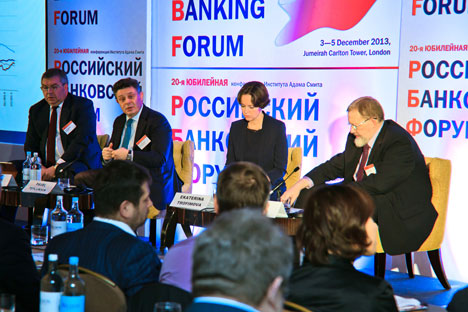
The general consensus at the conference found that the banking industry will have to adjust to the ‘non-growth economy’ at 1,2% GDP rise and hope for a consistent monetary policy. Source: Adam Smith Conferences
The timing of the Russian Banking Forum this year was perfect to have a feel of the expert sentiment around the most recent industry shake-up, i.e. Master Bank’s license withdrawal by the Central Bank of Russia. Coupled with the restrictions coming up with the Basel III implementation this suggests a tightening regulatory grip of the newly set up mega-regulator. The response to its activity from the authorities as well as banking community was expectedly cautious and reserved.
The clamp down on Master Bank for over $61 million in alleged illegal banking transactions and more recently Volga Social Bank and Smolensky bank is branded by authorities as an attempt to clean up Russia’s banking system from the dubious ‘pocket banks’ inherited from the 1990s.
According to Pavel Teplukhin, Chief Country Officer, Deutsche Bank Russia, “Master Bank could have been saved”. In the situation of multiple legal violations there is still a spectrum of ‘sanation’ as well as pre-emptive measures that could be applied to the bank instead of downright closure, he says.
Too big to fail
The internal implications could range from the apparently intended self-regulation by industry players ahead of direct intervention by the regulator to a degree of panic around an assumed ‘blacklist’ of the next victims. Banks are certainly keen on observing the rules of compliance but want them transparent as well as feasible.
According to Sergei Aleksashenko, Director of Macroeconomic research at Higher School of Economics, in a situation where the top 50 banks account for over 80% of the banking sector with Sberbank alone accounting for 45%, all state banks are in effect ‘one state bank’. The competition is extremely tough, experts admit, but it’s up to the regulator to work out the rules to keep it balanced. How this balance can be struck is not obvious.

Tinkoff Credit Systems founder Oleg Tinkov talks to Bloomberg's Ryan Chilkote about his innovative banking business. Source: Adam Smith Conferences
The deeper consequences could be a mass migration of account holders from private to state banks, which are perceived by as ‘secure by default’. Any new big cases are highly unlikely in the next few months in the run-up to the Olympic Games in Sochi, according to Chris Weafer of Macro Advisory, but there will certainly be a follow-up, he says.
Who’s going to handle the risks?
The looming external implications of the consolidation look complex. On the one hand, an emerging stricter regulatory landscape in Russia is in line with the post-crisis global trend of a tighter grip on the financial systems. The Basel III implementation is seen as another tool of disciplining the internal banking sector and streamlining it with the rest of the world to make the financial industry more accountable, transparent and predictable for investors. As Sergei Dubinin, Chairman of the VTB Supervisory Council, remarked, given that the derivatives market is almost non-existent in Russia, Basel III requirements could be implemented in Russia even ahead of other countries.
Nicholas Chitov, Chairman of the Board of Directors, Housing Finance Bank:
The consolidation of the banking sector is a legitimate process. At present over 90% assets in the banking sector are held by the credit organisations with owned capital over one billion roubles. This means that the consolidation did not start today or yesterday but goes back to 2008, when it became obvious that the crisis can be handled only by raising requirements to capital and banks' liquidity. Therefore, the CBRF measures do not set a new trend but rather manifest a natural evolutionary stage in the sector whereby the banks, which failed to learn the lesson of 2008, are pushed out of the market.
On the other hand, there are concerns about the stringent Basel III requirements setting the bar very high even for the big banks, which minor banks could find impossible to comply with thus leaving the market through closure or M&A. Apart from the stifling overregulation, doubts are voiced about the viability of the standard’s implementation in differing national legal and financial contexts.
Delayed introduction in individual countries due to the necessary adjustments means the whole transition is being pushed into the long grass as it does not make sense for any country to go ahead with unilateral self-imposed restrictions in a highly competitive environment. This creates a threat of pushing the sector back into the grey area, warns Teplukhin: “Banks are there to hold the risks. If they are stripped of this capacity through tight regulation, the risks will shift into the shadow market. It might be wiser to leave them in the environment which is regulated by viable professional tools”.
Systemic challenges
Regulation is, however, not likely to help the microeconomic outlook and turn the trend of falling foreign investment. The general consensus at the conference found that the banking industry will have to adjust to the ‘non-growth economy’ at 1,2% GDP rise in the third quarter and hope for a consistent monetary policy.
A few foreign banks have recently withdrawn Russian operations, which is down to the inefficiency of the market regulation as well as the emerging trend of banking concentration on the core national markets in the wake of the crisis and the EU financial issues. However, a bigger concern is the shrinking marginality of the banking business compared to the booming 2000s. This is aggravated by the economic stagnation due to deep systemic unbalance coming from the oil & gas based concept of growth and poor redistribution of the revenues from the commodities sector.
Fixing those inefficiencies is Russia’s remaining competitive advantage, according to Roland Nash, Verno Capital Partner. He also places a lot of hope with private ‘creative disruptors’ driving growth in Russia. The question is how much room for innovative initiatives a tougher monetary regulation leaves.
All rights reserved by Rossiyskaya Gazeta.
Subscribe
to our newsletter!
Get the week's best stories straight to your inbox